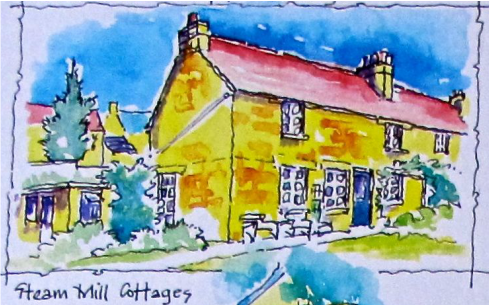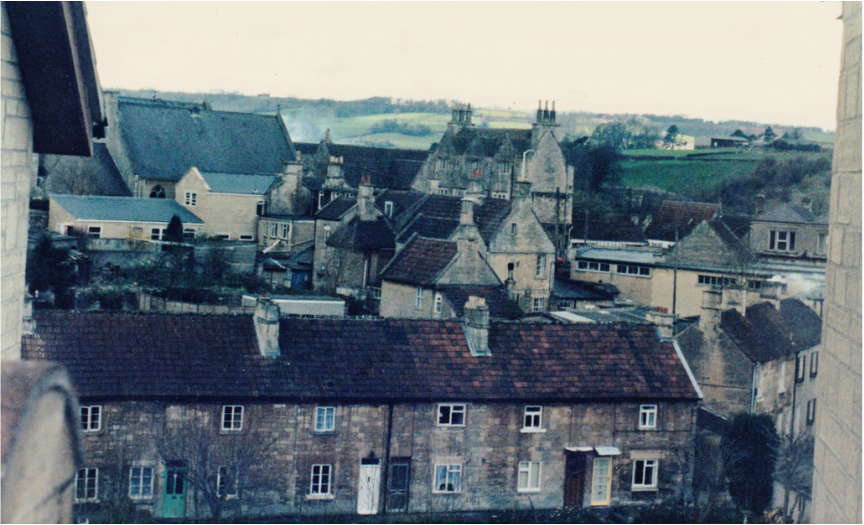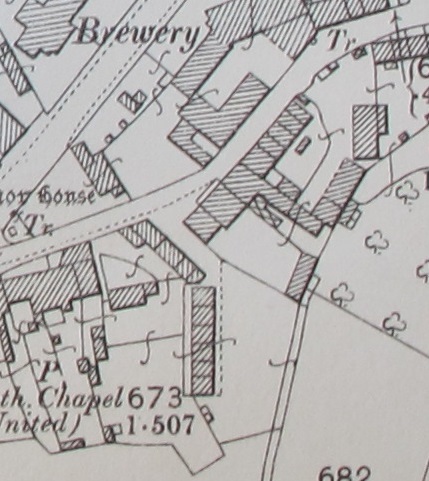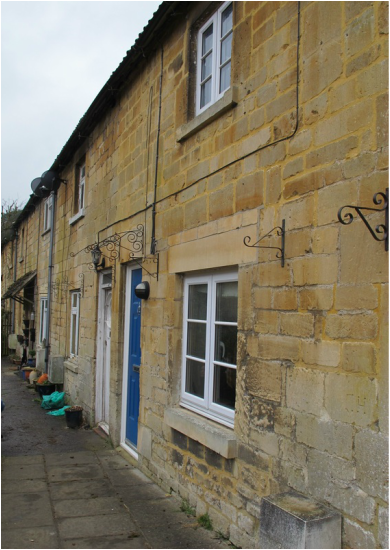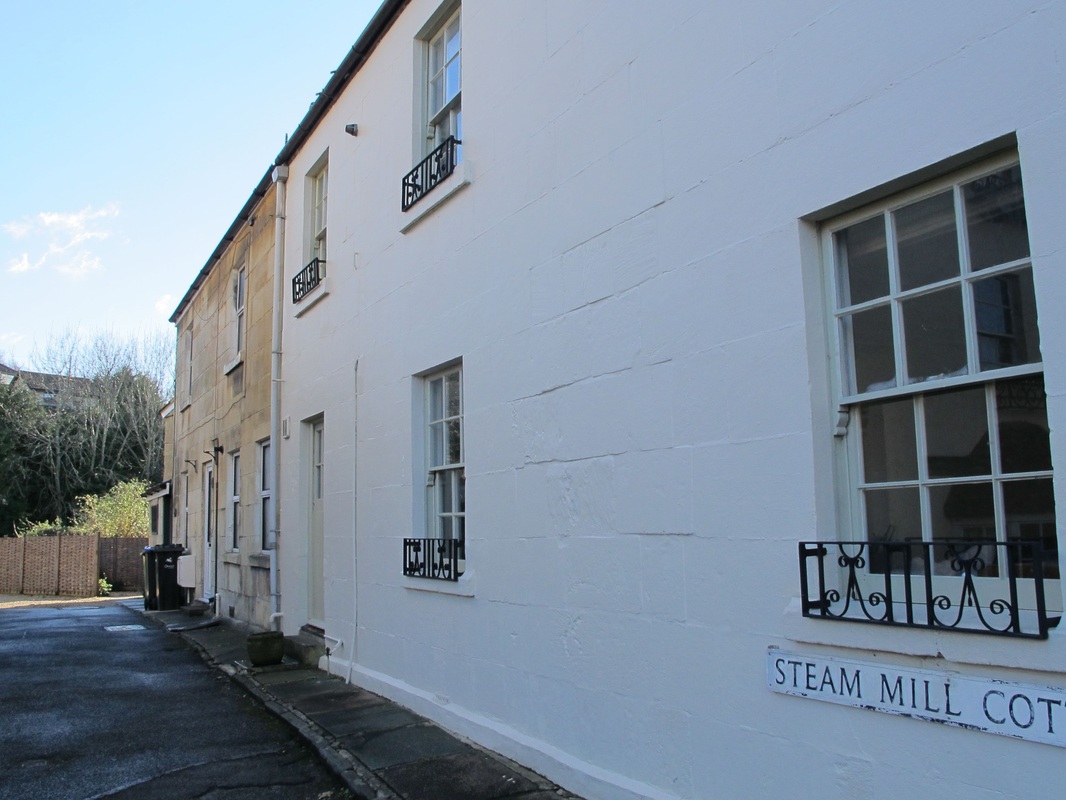|
Box Steam Mill
The history of this area is written from information contributed by resident, Val Wilson April 2015 Like me, have you ever wondered about the curious area called Steam Mill in Box Market Place? It is a self-sufficient, charmingly quiet hamlet in the centre of the village. But what is its history? Box already has several water-mills on the By Brook. So why did it need another mill, who built it and when? |
Box Steam Mill
It has been suggested that Dalebrook in the Market Place was the old Box Steam Mill.[1] But there is no evidence for this claim; nor is this mentioned in the Historic Buildings Listing, where Dalebrook is said to date from the early 1800s.[2] It also has to be said that Dalebrook does not look like a mill building; so is this the right building? If not, where was the Box Steam Mill?
The Market Place location was ideal for a steam mill, right in the centre of the village with numerous water springs on the site needed to generate the steam power. Locally, the use of stationary steam engines for manufacturing began early in the 1800s after the first engine was built at Trowbridge in 1805.[3] However, the 1840 Tithe Apportionment map makes no reference to a steam mill in the Market Place. In fact the whole site (including an extensive amount of land to the south) is called a house and garden owned by Isaac Miles and occupied by John Ovens.
The first identifiable reference to the name Steam Mill was in 1871 when George Browning (born 1827) lived in a property by this name, calling himself a baker and employing one man. He had only recently taken over the property because, until at least 1861, he had lived with his father, Thomas Browning, at Drewetts Mill, where they were described as farmers and millers.[4] George lived at Steam Mill until at least 1891, with his son James (born 1863), daughters Frances V (b 1868), Blanche (possibly called Amy born 1875) and Gertrude (born 1876). We might imagine that the milling trade was difficult: in 1881 he described himself as Corn Factor and Baker and in 1891 as baker.
By 1901 the building (by now not named) was occupied by George Newman (b 1849) who continued there until 1911 calling himself variously Pork butcher and baker and sometimes just baker. George Newman died on 2 April 1928 leaving £617.10s.11d to his widow Elizabeth. At an age approaching 80 years, we might imagine that the business had greatly diminished or stopped altogether. By 1939 the building is called Dalebrook and was a private house, occupied by Mr & Mrs AH Hillier.[5]
It has been suggested that Dalebrook in the Market Place was the old Box Steam Mill.[1] But there is no evidence for this claim; nor is this mentioned in the Historic Buildings Listing, where Dalebrook is said to date from the early 1800s.[2] It also has to be said that Dalebrook does not look like a mill building; so is this the right building? If not, where was the Box Steam Mill?
The Market Place location was ideal for a steam mill, right in the centre of the village with numerous water springs on the site needed to generate the steam power. Locally, the use of stationary steam engines for manufacturing began early in the 1800s after the first engine was built at Trowbridge in 1805.[3] However, the 1840 Tithe Apportionment map makes no reference to a steam mill in the Market Place. In fact the whole site (including an extensive amount of land to the south) is called a house and garden owned by Isaac Miles and occupied by John Ovens.
The first identifiable reference to the name Steam Mill was in 1871 when George Browning (born 1827) lived in a property by this name, calling himself a baker and employing one man. He had only recently taken over the property because, until at least 1861, he had lived with his father, Thomas Browning, at Drewetts Mill, where they were described as farmers and millers.[4] George lived at Steam Mill until at least 1891, with his son James (born 1863), daughters Frances V (b 1868), Blanche (possibly called Amy born 1875) and Gertrude (born 1876). We might imagine that the milling trade was difficult: in 1881 he described himself as Corn Factor and Baker and in 1891 as baker.
By 1901 the building (by now not named) was occupied by George Newman (b 1849) who continued there until 1911 calling himself variously Pork butcher and baker and sometimes just baker. George Newman died on 2 April 1928 leaving £617.10s.11d to his widow Elizabeth. At an age approaching 80 years, we might imagine that the business had greatly diminished or stopped altogether. By 1939 the building is called Dalebrook and was a private house, occupied by Mr & Mrs AH Hillier.[5]
Steam Mill Cottages
So far there has been no reference to the rank of cottages that run alongside the path next to Dalebrook. They run at two different angles: three leading off the Market Place, and six running at an angle to the others. Their unusual direction appears to indicate that they were built to maximise development in the garden of Dalebrook.
Some of the properties are referred to in the deeds when they say: three of which were erected by one James Winckworth.[6] These must have been built before 1888 because James Winkworth, a builder and plasterer from Walcot, Bath, died aged 53 years on 16 March 1888. It is possible that these were the first three properties on the Market Place and were built before the others.
Six of the properties were built after 1874 because there is an interesting newspaper advertisement in 1874 asking for building tenders for the site: Builders desirous of tendering for the erection of six cottages at Box Wilts (should apply to) W Webb, Esq to see plans for the same at the Steam Mill, Box.[7]
Local knowledge has also suggested that the buildings were developed over a number of years, by different builders, because each cottage is slightly different. The deeds say that Stephen Ambrose of Bath took out a mortgage of £600 on the site on 25 June 1888. Perhaps he acquired the site on the death of James Winckworth. Stephen Ambrose was an important building contractor from Bath, sometimes called the Father of Bath Builders because of his role in founding the local Builders' Federation.
So far there has been no reference to the rank of cottages that run alongside the path next to Dalebrook. They run at two different angles: three leading off the Market Place, and six running at an angle to the others. Their unusual direction appears to indicate that they were built to maximise development in the garden of Dalebrook.
Some of the properties are referred to in the deeds when they say: three of which were erected by one James Winckworth.[6] These must have been built before 1888 because James Winkworth, a builder and plasterer from Walcot, Bath, died aged 53 years on 16 March 1888. It is possible that these were the first three properties on the Market Place and were built before the others.
Six of the properties were built after 1874 because there is an interesting newspaper advertisement in 1874 asking for building tenders for the site: Builders desirous of tendering for the erection of six cottages at Box Wilts (should apply to) W Webb, Esq to see plans for the same at the Steam Mill, Box.[7]
Local knowledge has also suggested that the buildings were developed over a number of years, by different builders, because each cottage is slightly different. The deeds say that Stephen Ambrose of Bath took out a mortgage of £600 on the site on 25 June 1888. Perhaps he acquired the site on the death of James Winckworth. Stephen Ambrose was an important building contractor from Bath, sometimes called the Father of Bath Builders because of his role in founding the local Builders' Federation.
|
Using the census records we can pinpoint the date of the cottages better. None of the cottages appear in the 1881 census; however, they are all built by the time of the 1885 Ordnance Survey of Box. So the cottages were all built between 1881 and 1885, many years after George Browning called his house Steam Mill in 1871.
Finally, the property deeds reveal the site of the original Box Steam Mill when they recite the history of the site saying that the corn or grist Mill which formerly stood thereon having been pulled down. So the origin of the Mill factory itself was an earlier building now occupied by the cottages and George Browning's garden. Steam Mill House (now Dalebrook) was therefore the house belonging to the mill owner. Right: Extract of Ordnance Survey map of 1900 which clearly shows ten properties (some being sub-divisions of the current buildings). Courtesy Wilts History Centre. |
|
Residents at Steam Mill Cottages
We get a fascinating insight into the people who lived in this row of cottages around the turn of the century. In 1900 the cottages were sold to William Woodbridge of Walcot Street, Bath for £750 who let them out until his death in 1924. Some families lived there for decades. Sarah Rebbeck (nee Ash), who married in 1872, moved to one of the cottages from Wadswick after the death of her husband, Theophilus, an agricultural labourer in 1896. She stayed there for much of her life until her death in 1923. It was a closely-knit community with some families transferring in the terrace, like John Joseph Hood who downgraded from number 1 to number 4 between 1891 and 1901. The Phelps lived in the end cottages throughout the period 1881 to 1911. The type of resident was broadly similar during the years between 1891 and 1911: mostly quarrymen or labourers and their families; none of them mill staff. We might imagine that the number of widows with restricted incomes in the census meant that the properties were cheaper to rent with limited domestic gardens and perhaps rather poorly maintained by the landlord.. Left: The row of six cottages at the rear of the lane (photo courtesy Carol Payne) |
In the 1911 census, residents are listed for each property as:[8]
1 Mill Cottages: William Fisher, brewer's carter, with wife and 2 children in 4 rooms
2 Mill Cottages: George Fortune, farm labourer, with wife and 4 children in 5 rooms
3 Mill Cottages: Mrs Augusta Shepperd, daily domestic servant, alone in 2 rooms
4 Mill Cottages: Mary Phelps, widow, with road labourer son in 4 rooms
5 Mill Cottages: Catharine Pullin, widow, with son and daughter in 4 rooms
6 Mill Cottages: Mary Smart,82, widow and old age pensioner, alone in 5 rooms
7 Mill Cottages: Sarah Rebbeck, widow, with 4 children, 2 grandchildren, 4 rooms
8 Mill Cottages: Henry Phelps, quarryman chopper, wife, 2 children, 1 grandchild, 4 rooms
9 Mill Cottages: William Phelps, free stone sawyer, with wife and 1 child in 4 rooms
1 Mill Cottages: William Fisher, brewer's carter, with wife and 2 children in 4 rooms
2 Mill Cottages: George Fortune, farm labourer, with wife and 4 children in 5 rooms
3 Mill Cottages: Mrs Augusta Shepperd, daily domestic servant, alone in 2 rooms
4 Mill Cottages: Mary Phelps, widow, with road labourer son in 4 rooms
5 Mill Cottages: Catharine Pullin, widow, with son and daughter in 4 rooms
6 Mill Cottages: Mary Smart,82, widow and old age pensioner, alone in 5 rooms
7 Mill Cottages: Sarah Rebbeck, widow, with 4 children, 2 grandchildren, 4 rooms
8 Mill Cottages: Henry Phelps, quarryman chopper, wife, 2 children, 1 grandchild, 4 rooms
9 Mill Cottages: William Phelps, free stone sawyer, with wife and 1 child in 4 rooms
|
Recent Residents
The people who lived in the row of cottages were often unusual individuals who enjoyed the communal spirit of the rank. In the Second World War three of the cottages were occupied by Bevin Boys who came from South Wales to help get Box's underground aircraft facilities in working order. For many years Bill Peters and his wife lived in cottage 1. Bill was a very popular figure in the village, an ex-jockey, who frequently drove through the centre of Box in his horse and carriage. At number 6 was Mrs Cottrell who was the village laundress. She drew her water supply from Dodds' yard across the Market Place. The Hillman family have lived in various of the properties and Mary Hillman still occupies one. |
The story of Box's Steam Mill is complex, reflecting the rapidly changing economic and social conditions in the village in the late Victorian period. Circumstances altered with the advent of cheaper travel by rail and imported commodities resulting from free trade brought in by the abolition of the Corn Laws in 1846. Local mills became increasingly unprofitable and the skill of the miller ceased to be important as mass production overtook local trade connections. So Box's Steam Mill in the Market Place closed and was pulled down, and was replaced by rental properties which guaranteed an income for the owner. They have remained a charming residential terrace ever since.
References
[1] Village Guide published by Box Parish Council and Box Parish Guide produced by Boxlea WI
[2] Historic Buildings, p.102
[3] MC. Corfield, Guide to Industrial Archaeology of Wiltshire, p.32
[4] See separate article in this issue
[5] Bath Chronicle and Weekly Gazette, 3 June 1939
[6] Abstract of Title kindly shown by Val Wilson
[7] Bath Chronicle and Weekly Gazette, 21 May 1874
[8] One of the cottages had been divided into two separate residences.
[1] Village Guide published by Box Parish Council and Box Parish Guide produced by Boxlea WI
[2] Historic Buildings, p.102
[3] MC. Corfield, Guide to Industrial Archaeology of Wiltshire, p.32
[4] See separate article in this issue
[5] Bath Chronicle and Weekly Gazette, 3 June 1939
[6] Abstract of Title kindly shown by Val Wilson
[7] Bath Chronicle and Weekly Gazette, 21 May 1874
[8] One of the cottages had been divided into two separate residences.
